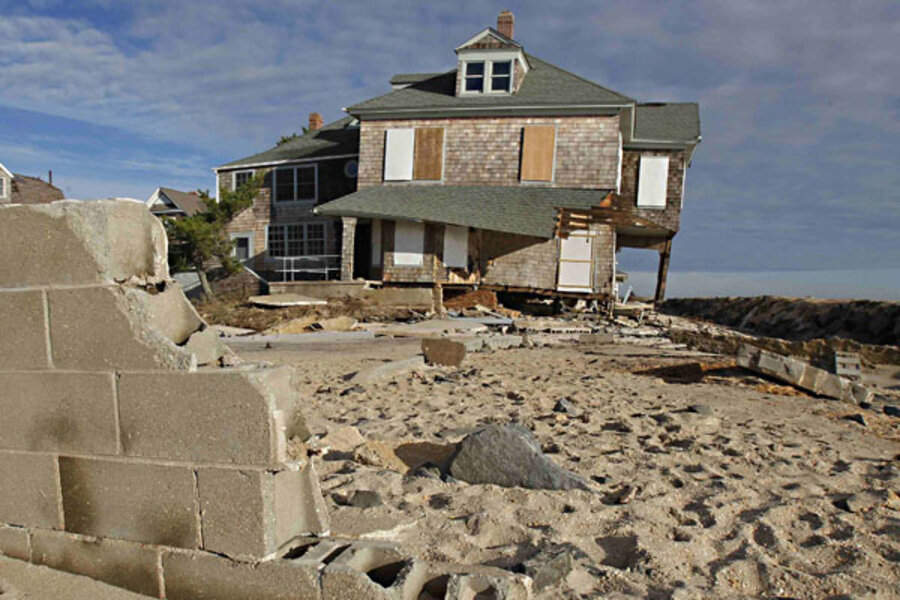Five insurance lessons from Sandy
Loading...
If water falls from the sky, most homeowners policies will provide coverage. If it comes from anywhere else, it’s a different story.
That’s a rule of thumb many of the 60 million people affected by Superstorm Sandy will be learning today. And some may be discovering their deductible – the portion of the damage they’re expected to pay before their insurance kicks in – is thousands more than they expected.
Whether you were affected by Sandy or not, here are some important insurance takeaways.
If you live near the coast, you may have a higher deductible than you think
As those living in parts of the U.S. prone to hurricanes already know, some insurance policies come with much higher deductibles for any claim related to hurricane damage. Rather than the typical $500 or $1,000 deductible, for example, hurricane deductibles are expressed as a percentage of a home’s insured value, typically 1 to 5 percent. So in the case of a $300,000 home, the deductible would range from $3,000 to $15,000.
States where these higher insurance deductibles are allowed include places you’d expect, like Alabama, Florida, Georgia, Hawaii, Louisiana, Mississippi, and Texas. But they also include states you might not expect, like many of those in Sandy’s path: Virginia, Connecticut, Delaware, Maine, Maryland, Massachusetts, New Jersey, New York, North Carolina, South Carolina, Rhode Island, and the District of Columbia.
Just because you live in a state that allows higher hurricane deductibles doesn’t mean your policy includes them. The way to find out is to pull out your policy and look at it. In addition, you’ll have to find out the exact description of a storm that triggers the deductible. In some policies, the operative language is only when a hurricane is declared, while a tropical depression may trigger higher deductibles in others. In still other cases, specific wind speeds must be reached.
If you don’t have flood insurance, you may be out of luck
No matter where you live, your policy most likely excludes damage from flooding, which typically means water that rises from the ground, not the sky. So if water from a storm surge or cresting river invades your home, only a flood policy will pay. Should damage occur due to rain entering because a tree destroys your roof or breaks a window, however, you’d be covered by a typical homeowner’s policy.
Think before you file
When your home suffers damage, your immediate response is to contact your insurance company and report it. While that’s a good thought – many claims are processed on a first-come, first-served basis – making that call before you’re fully prepared could cost you thousands in reimbursed damages. Understand your policy first: Don’t let an insurance company representative be the one driving the bus.
Step one is always to read your policy and determine, as best you can, specifically what’s covered and what’s not. In addition to deductibles, take note of the amount of coverage you have for dwelling, contents, and loss of use. Then look for exclusions like flood or other perils, as well as exclusions or limitations for specific types of property, like art, computers, and jewelry.
Step two is to document everything. Take pictures to show exactly what damage has been done to your property and take a complete inventory of everything affected. And be aware that it is your responsibility to protect your property from additional damage to the best of your ability.
File your claim
Once you know what should be covered and exactly what you’ve lost, make the call. Avoid any potential trigger terms, like “flood.” Don’t get into a long conversation about what happened or what you think should or might be covered. Just provide a simple and concise description of the damage and ask what to do next.
Be prepared to take notes of everyone you talk to, including names, dates, and what was said. Once you’ve reported your loss, you’ll be assigned an adjuster: Get their contact information, including their phone number, email address, and supervisor.
When the adjuster arrives, recognize that they will likely be stressed out, just like you are. In the case of widespread damage like that from Sandy, adjusters will be brought in from all over the country, working 14-hour days dealing with emotionally devastated people, many of whom will be demanding, suspicious of their insurance company, and otherwise difficult to work with. Stand out from the crowd by being friendly, calm, and most important, prepared.
As with everyone else you deal with, take notes of what the adjuster says.
The time to learn how insurance works isn’t in the aftermath of a storm
Disasters like Sandy will offer firsthand experience on dealing with insurance companies to those affected. But it should offer a wake-up call to everyone with homeowners insurance. The trend of the last decade, especially in regions where natural disasters have occurred or are likely to occur, is for insurance companies to charge more and pay out less.
Take a moment this weekend to review your homeowners coverage, including cost and exclusions. If you’re ever in the path of a storm like Sandy, you’ll be glad you did.
Stacy Johnson is the founder and editor-in-chief of Money Talks News, a consumer/personal finance TV news feature that airs in about 80 cities as well as around the Web. This column first appeared in Money Talks News.







